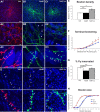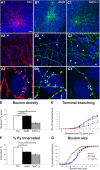Neural activity and neurotransmission regulate the maturation of the innervation field of cortical GABAergic interneurons in an age-dependent manner
- PMID: 22262889
- PMCID: PMC6621145
- DOI: 10.1523/JNEUROSCI.4352-11.2012
Neural activity and neurotransmission regulate the maturation of the innervation field of cortical GABAergic interneurons in an age-dependent manner
Abstract
Neural activity guides the patterning of neuron synaptic territory in the developing nervous system. Evidence supporting this hypothesis comes from numerous studies on projection neurons in neuromuscular and visual systems. It is unknown whether the innervation field of GABAergic interneurons, which forms local dense innervations, follows similar rules. Cortical basket cells innervate hundreds of pyramidal cell somata and proximal dendrites. Thanks to this connectivity pattern, they can tightly control neural excitability and synchronization. Here we show that reducing excitation, and thus neurotransmitter release, in mouse cortical single basket cells in slice cultures decreases the number of innervated cells without changing the pattern of perisomatic innervation, both at the peak and after the proliferation phase of perisomatic synapse formation. Conversely, suppressing neurotransmitter release in single basket cells can have completely opposite effects depending on the developmental stage. Our results reveal a remarkably specific and age-dependent role of neural activity and neurotransmission levels in the establishment of the synaptic territory of cortical GABAergic cells.
Figures




References
-
- Ango F, di Cristo G, Higashiyama H, Bennett V, Wu P, Huang ZJ. Ankyrin-based subcellular gradient of neurofascin, an immunoglobulin family protein, directs GABAergic innervation at purkinje axon initial segment. Cell. 2004;119:257–272. - PubMed
-
- Bosman LW, Konnerth A. Activity-dependent plasticity of developing climbing fiber-Purkinje cell synapses. Neuroscience. 2009;162:612–623. - PubMed
Publication types
MeSH terms
Substances
Grants and funding
LinkOut - more resources
Full Text Sources
Medical
Molecular Biology Databases
